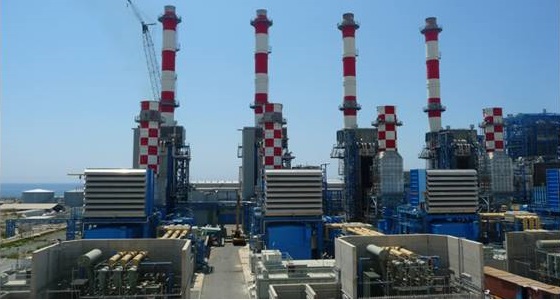Vasilikos
Power Station is the biggest infrastructure project ever carried out in Cyprus.
Its importance is closely linked to the country's broader economic growth.
It is an
advanced technology power station consisting of:
Three
conventional generation units, each with a generating capacity of 130 MW,
fuelled by heavy fuel oil. All three units have been
fitted with emissions abatement technologies for the reduction of nitrogen
oxides, sulphur dioxides and dust in order to to reduce those emissions below the levels set by the
European Large Combustion Plant Directive. In addition the boilers have
been converted to burn both HFO and natural gas.
One 38 MW Gas
Turbine fuelled by diesel oil.
Two Combined
Cycle Gas Turbine units, each with a capacity of 220 MW, fuelled by diesel
oil and with the potential to be adapted to use natural gas for fuel.
One additional Combined Cycle Gas Turbine Unit of a capacity of 160 MW fueled by both Natural Gas and diesel oil, as a backup fuel, is expected to be delivered for commercial operation in 2024.

On 11
July 2011, following an explosion at the Mari naval base, Vasilikos Power
Station, which lies adjacent to the naval base, suffered heavy damage that
brought its operations to a complete standstill. The power station has since
been repaired and is fully operational once more.
Vasilikos
Power Station generates 65% of the total generation produced by the
Authority's Power Stations.
The
thermal efficiency for units generated of the three conventional units is about
38%, while that of Combined Cycle Units is about 48%.
Directive
2012/18/ΕU of the European Parliament and the Council of 4 July 2012 on the
control of major-accident hazards involving dangerous substances amending and
subsequently repealing Council Directive 96/82, requires that the operator
(EAC – Vasilikos Power Station) produce a Safety Report. Vasilikos Power
Station produced its Safety Report in accordance with the
above European Directives in 2008-2009. It was completely revised in 2019.
Vasilikos Power Station's Major Accident Prevention Policy Manual
presents the commitment of the Electricity Authority of Cyprus to the
prevention of major accidents and the limiting of their impact, so as to ensure
a high level of protection for human life and the environment.